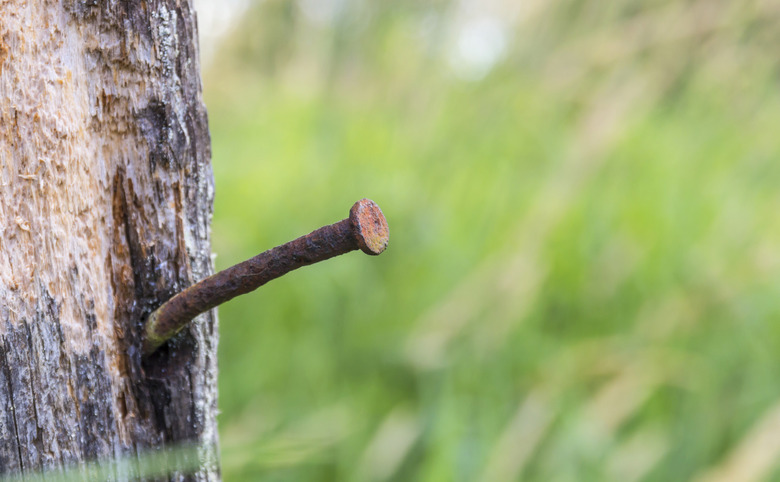Experiments On The Rusting Of Iron Nails
Rust is a broad topic of discussion for science classrooms at all grade levels. While elementary teachers present rusted metal as a simple example of a chemical reaction, high school instructors point to rust in explanations of oxidation and reduction reactions. Students in public school or home school are able to perform experiments on rusting iron nails for class research assignments or science fair projects.
Comparing Corrosion
Comparing Corrosion
Intermediate students who prepare for assignments in advance can determine which liquids cause rust formation fastest on submerged iron nails. Gather six beakers or drinking glasses. Add 1 cup of tap water to the first, 1 cup of salt water to the second, 1 cup of a carbonated lemon-lime soda to the third, 1 cup of pickle juice to the fourth container, 1 cup of orange juice to the fifth and 1 cup of white vinegar to the last cup. Hypothesize what liquid will cause a nail to rust first. Submerge one iron nail in each container and set the beakers or glasses in a place they will not be disturbed. Observe the nails daily to check for rust formation. The nails in water should both form rust within three weeks, and the vinegar should rust a nail approximately one week later. The soda and juices should not cause any rust to form on the nail.
Accelerated Oxidation
Accelerated Oxidation
A dessicator is a two-level cabinet that maintains contents in a completely dry atmosphere. Samples are placed on a layer of wire gauze, and a drying agent, such as silica gel, is stored on the base level. Purchase a small dessicator online or from a medical supply store. Place three clean, dry iron nails on the wire gauze layer in the dessicator and put 10 grams of calcium chloride crystals on the bottom of the dessicator. Dip three nails in water before hanging them outside the dessicator by using wire to attach them to the dessicator door handle. Observe and record data for one week. While the nails outside the dessicator should form rust, the nails inside will remain clean. Students should see from the results that moisture is a key element in rust formation and must present in the air surrounding iron for oxidation to occur.
Temperature Changes
Temperature Changes
Hypothesize whether cold or warm air temperatures will affect the rate at which rust forms on iron nails.Gather nine iron nails and three beakers or glass containers of the same size. Place three nails into a container filled with tap water. Place three nails in a container and fill with ice cubes. Place the remaining nails in a container filled with tap water and place under a heat lamp. Leave all three containers uncovered in an undisturbed area and observe daily for one week. Ice must be added to the second container frequently to maintain a cold environment throughout the experiment. Oxygen, the primary component of rust formation, combines with other elements, including iron, more readily at warmer temperatures, so the nail under the heat lamp should rust first, while the nail in ice should be the last to form rust on its surface.
Density of Rust
Density of Rust
Density experiments are versatile to fit most age levels. Students should hypothesize how the oxidation reaction that produces rust on iron nails affects the density of the nails. Purchase 2 pounds of iron nails and separate into 1 pound groups. Ensure the mass and volume of each group is equivalent. Leave one group indoors so rust will not form on them. Allow the second group to rust naturally outside, or accelerate the rust formation using a technique from the previous experiments. When oxidation is complete, calculate the mass and volume of the second group to determine whether any change in density occurs during oxidation. Rust is less dense than iron, but a gram of iron will yield more than 1 gram of rust, so students should observe a weight gain, and therefore an increase in density, in the rusted set of nails.
Cite This Article
MLA
Tresor, Adelaide. "Experiments On The Rusting Of Iron Nails" sciencing.com, https://www.sciencing.com/experiments-rusting-iron-nails-8612314/. 24 April 2017.
APA
Tresor, Adelaide. (2017, April 24). Experiments On The Rusting Of Iron Nails. sciencing.com. Retrieved from https://www.sciencing.com/experiments-rusting-iron-nails-8612314/
Chicago
Tresor, Adelaide. Experiments On The Rusting Of Iron Nails last modified August 30, 2022. https://www.sciencing.com/experiments-rusting-iron-nails-8612314/
